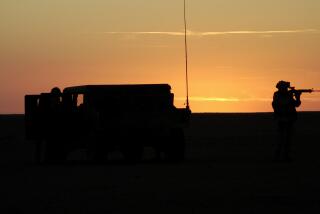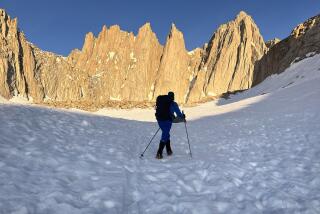High and Low of Marine’s Quest
- Share via
DEATH VALLEY — A Marine Corps major who lost a lung when he was wounded in Vietnam began a nonstop 146-mile run Wednesday that will take him from the blistering desert floor 282 feet below sea level here to the 14,464-foot peak of Mt. Whitney.
Maj. John Bates is not the first person to attempt the grueling run, which will begin at the lowest spot in North America and end at the highest point in the contiguous United States. But he may be the brassiest of the dozen or so people who have done it.
Before issuing a permit for the endurance run, Death Valley National Monument Acting Chief Ranger Russell March sternly warned Bates: “Now look, I don’t want you dying on me, OK? This is the closest to hell you’ll ever get.”
“I love this weather,” said Bates, moments before starting his run on a sizzling salt flat where the temperature was 119 degrees at 8 p.m.
A friend fired a .45-caliber pistol into the air, and Bates jogged off in red, gold and white shorts, shoes and a jersey. “And we’re gone from here,” Bates said. “It’s about time we got this thing started.”
The 42-year-old veteran lost a lung when a Viet Cong bullet ripped through his chest Dec. 17, 1966. In separate incidents, he also caught grenade shrapnel in his left knee and lost all feeling in two toes after stepping on a punji stake trap.
So why, one might ask, is he doing this?
“My wife asks me that all the time,” said Bates, who is en route to his next assignment at the Marine Corps Air Station at Kanehoe, Hawaii. “The real honest deal is personal satisfaction. It also gives publicity to the Marine Corps and disabled Vietnam veterans by showing there is a lot more they can do with their lives.”
Bates is seeking to break two records. The first belongs to Gil Cornell of Lone Pine, who in 1987 made the run in the fastest recorded time of 45 hours, 15 minutes. The second is Bates’ personal best time of 63 hours, 12 minutes, which he made in September, 1986, and included two eight-hour stretches of sleep.
Max Cooper, 41, of Little Rock, Ark., who made the run with Bates in 1986, said he has no doubts about his friend’s ability.
“Even by ultra-distance runners’ standards, this is kind of a freaky idea,” Cooper said. “But John’s real good and a real determined guy. I really think he’ll be able to set a new record.”
Indeed, Bates, who has prepared for his second assault on the mountain by running about 100 miles a week in recent months, aims to finish in 40 hours.
With the help of Dr. John C. Holland, health fitness director at National Defense University in Washington, Bates said he has come up with “a bag of tricks” to boost his chances of success.
They include eating what he called a “whole smorgasbord” of salty foods, drinking large amounts of water and gobbling caffeine tablets to ward off sleep.
Although Bates was unable to find a doctor to accompany him on the run, “Dr. Holland, who has been doing scientific work in ultra-distance performance for some time, is having me keep a detailed diary of my fluid and food consumption.”
“From the time I leave Badwater, all that I will mentally picture is the top of Mt. Whitney. I’ll have tunnel vision,” Bates said. “If I do it in 40 hours, it’ll be a heck of an act to follow.”
Bates’ wife, Stephanie, 36, and their 10-year-old son, Joshua, plan to monitor his progress from an air-conditioned mobile home. Stephanie Bates had planned to be with her husband at the start of his run but had to take care of mechanical problems with the vehicle.
Pair to Join Him
About 11 miles from the Mt. Whitney summit, two other members of his support group, Marine Corps Gunnery Sgt. Doug Johnson and Sgt. Rosen Miller, will run with him to the top.
“It was 113 degrees in Death Valley the other day,” Johnson said. “But John’s going to do it nonstop with no sleep, no doctor, no nothin’.”
Chief Ranger Marsh had his doubts.
“It’s a bad time to be doing this,” Marsh said. “He may be the premier runner in the nation, but Mother Nature has the last word.”
More to Read
Sign up for Essential California
The most important California stories and recommendations in your inbox every morning.
You may occasionally receive promotional content from the Los Angeles Times.










